A few days ago, the Cleveland Indians signed Oliver Perez to a one-year, $2.5 million contract with a vesting option for the 2020 season. Upon seeing the headline, I was amused. I thought Perez had been out of the league for half a decade at this point. Perez has decidedly not been out of the league. In fact, he’s pitched every season since 2012 — and more recently, he’s been thriving.
This is going to surprise you — if not, I’m certainly not ashamed to say I was taken aback. Of pitchers with 30 or more innings pitched, here is how Perez ranks:
- Second in ERA-.
- Seventh in K-BB%.
- Seventh in xFIP-.
- Fifth in SIERA.
- Fourth in xwOBA (>100 PA).
In 2017, Perez had a 4.64 ERA. The year before, he had a 4.95. Preceding that, 4.17. You get the gist. He was bad, and then he was good. Really, you could say he was elite.
Now first, let’s be transparent. The sample here is incredibly small. Perez pitched just 32.1 innings on the year. 17.1 of those came against lefties, while 15.0 came against righties. With more exposure, Perez may have been unremarkable. Maybe it’s small sample size, or perhaps hitters have not had sufficient time to adapt to the adjustments he appears to have made. Thus far, there isn’t much to suggest that Perez’s breakout is completely unsustainable.
For a while now, Perez has been effective against lefties. That isn’t new — Perez is a LOOGY, after all. His career xFIP versus lefties is 3.31. Now, he did improve against lefties, but what is notable here is he appears to have made a breakthrough against righties. Allow me to demonstrate. Perez’s xwOBA against RHB, by year:
- 2015: 0.343.
- 2016: 0.347.
- 2017: 0.364.
- 2018: 0.221.
How?
First, after using his slider 42.7% of the time for three years straight, Perez upped its usage to 49.0%. Second, Perez has been steadily using his four-seam fastball less and less for years now, but it dropped off a cliff this year from 31.3% to 12.6%. In its place, he has increased the use of his sinker.
That’s generally speaking, though, and there’s much more to Perez than that. Like most pitchers, Perez attacks hitters differently depending on who he’s facing. Versus lefties:
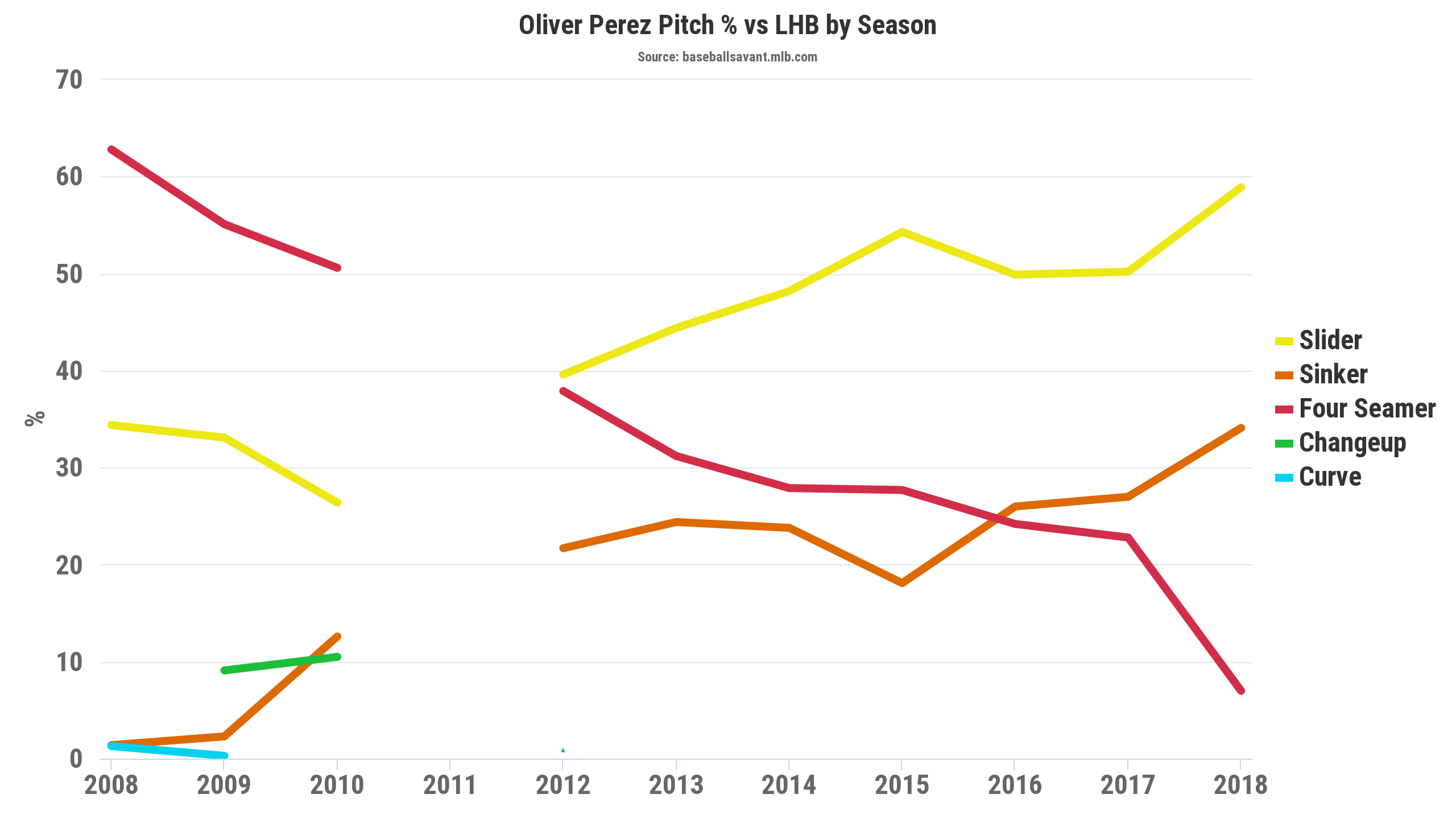
Against lefties, Perez favors a slider-heavy approach. He always has. But now, he utilizes his sinker — not his four-seamer — a third of the time while offering his slider almost two-thirds of the time. In other words, not a ton has changed, except his four-seam is nearly gone, replaced by his sinker.
Versus righties:
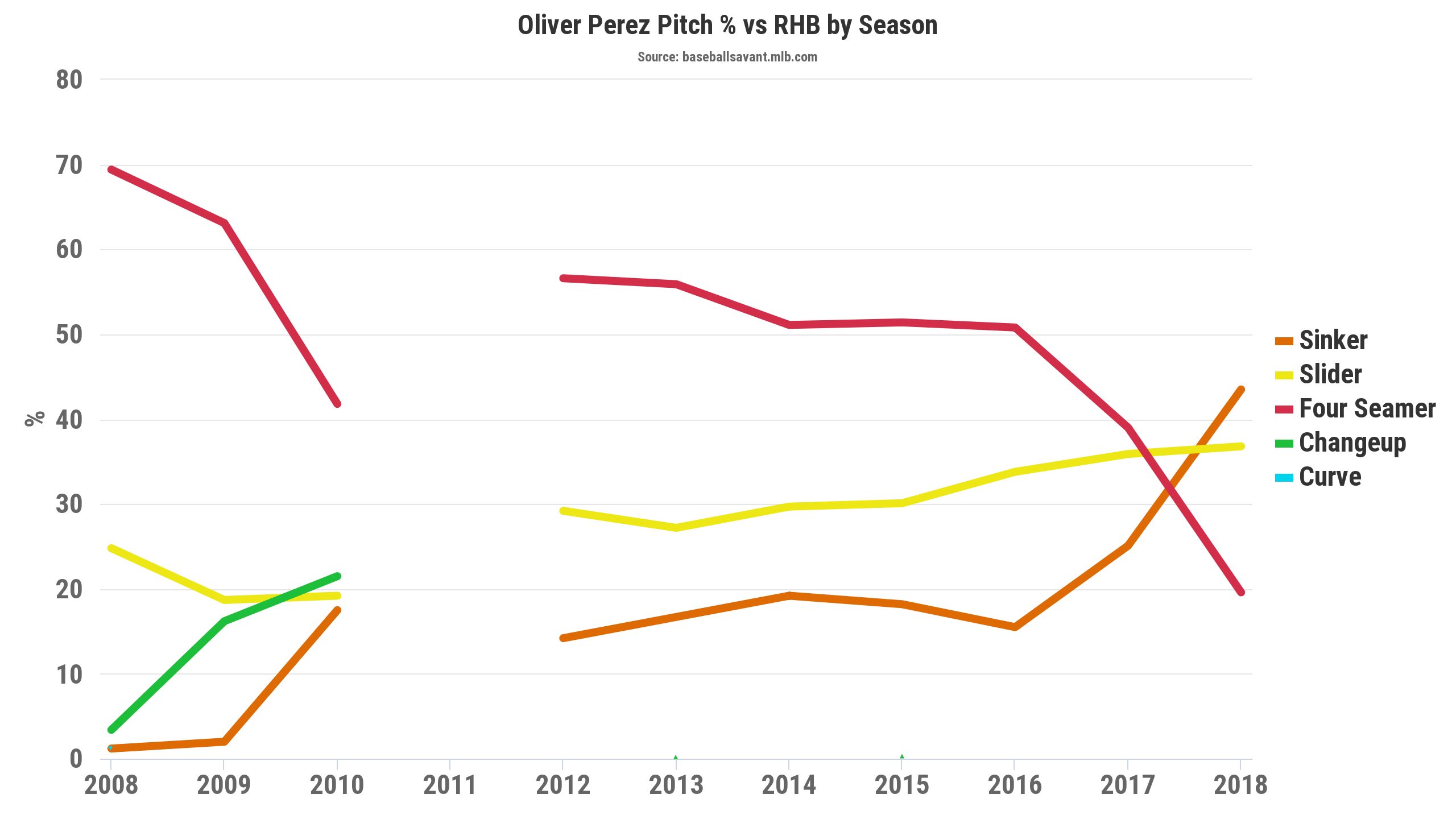
Perez has flipped the script against righties as well. In 2017, Perez threw his four-seamer against RHB more than his slider and sinker. In 2018, his four-seam was his least-used pitch. Consequently, his sinker became his most utilized pitch, followed by his slider, which remained stable in terms of usage.
It’s important to note that Perez’s fastballs, regardless of type, have always been a detriment to him.
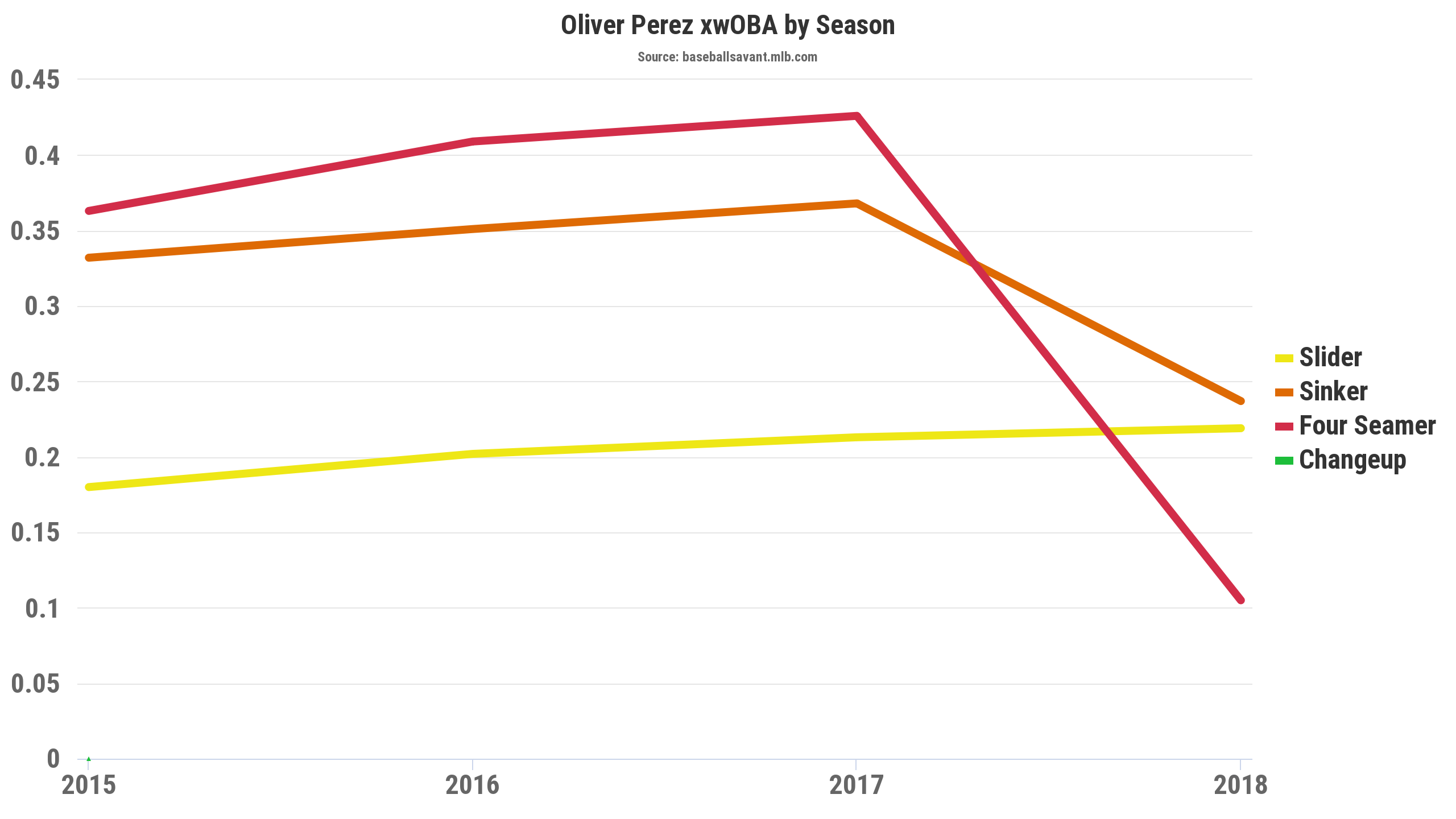
For the first time in his career, Perez had a fastball that was a weapon. Not only did he have one, he had both fastballs working in his favor.
It’s not as simple as using his slider and sinker more and his four-seam less. That explains a great deal of it, but to me, Perez has become a better pitcher. I’ve added four 3-D pitch visualizations, courtesy of Baseball Savant. I want to stress that with these types of visuals, it is easy to indulge in confirmation bias. That is, it is easy to go in with an assumption and to then erroneously validate it because of what one wants or expects to find. Surely I am no less susceptible to this. With that, I am going to interpret these with the caveats that there is no one right way to pitch, and my interpretation isn’t the only correct explanation. Away we go.
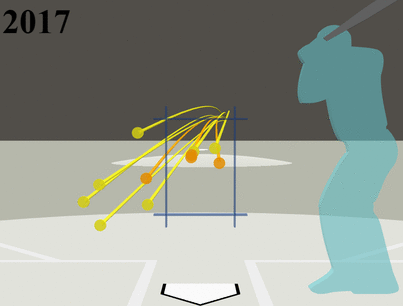
(Yellow = sliders, orange = sinkers, red = four-seamers)
Now, pitching against left-handed hitters was clearly never the issue, but there are a couple key differences here. First, Perez is doing his best to keep his sliders low and away. The ones that aren’t off the plate aren’t lingering over the plate as badly as in 2017. Second, he peppered in a few four-seam fastballs in on the hands of the hitter to keep him off balance. Lastly, he is doing better to locate his sinkers on the perimeters of the strike zone rather than in the middle of the plate.
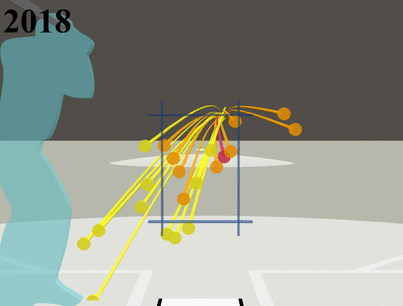
(Yellow = sliders, orange = sinkers, red = four-seamers)
In 2017, it’s difficult to say what Perez’s plan of attack was. Frankly, it’s a little perplexing to look at. His pitches are all over the place, and again, they’re hanging out over the plate more than they have been this year — at least in this instance. In 2018, Perez used his slider to attack the back foot of the hitter while alternating his sinkers and four-seamers on either side of the plate. Sure, there are sliders over the middle of the plate, but assuming they’re not hanging, they aren’t going to get touched up like a four-seam fastball in the middle of the zone.
Which brings me to this: Perez’s pitches have changed. His four-seam and sinker have changed more marginally, but his slider looks appreciably different from last year. Perez’s 2017 and 2018 sliders:
Here are his 2017 and 2018 pitches, plotted by horizontal and vertical movement:
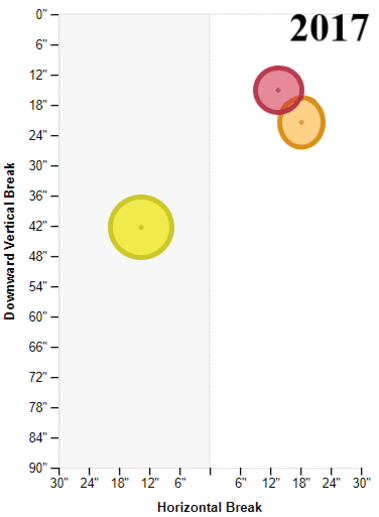
(Yellow = sliders, red = four-seamers, orange = sinkers)
And if it still isn’t obvious — for the more number-inclined folk:
| 2017 slider | 2018 slider | |
| Velocity | 79.5 | 78.8 |
| H-Mov | -13.6 | -8.6 |
| V-Mov | -42.3 | -46.6 |
Perez has never had this slider. Before, it was more of a sweeping Adam Ottavino-esque pitch, whereas now it’s more in the form of, say, Dallas Keuchel’s slider. It certainly isn’t a cutter — it’s far slower than his four-seam fastball and sinker, and it still moves quite a bit — but in terms of shape, it’s become increasingly similar to his fastballs in horizontal movement. This is where pitch tunneling comes into play.
Perez’s 2017 four-seam/slider pitch tunnel:
You can see that Perez’s four-seam and slider don’t travel on the same path for very long at all. Despite the poor pitch tunnel, J.T. Riddle isn’t able to do anything with either pitch. This isn’t surprising, though, as Riddle is left-handed.
Perez switched from a four-seam fastball to a sinker in 2018. Accordingly, his sinker/slider tunnel:
Now, it’s not a perfect pitch tunnel, but it was sufficient to cause Jake Bauers enough hesitation to take both pitches for strikes — one near the middle of the zone and another off the plate — yet close enough to be called a strike. This, as I understand, is the key to Perez’s breakthrough. Before, it was easy to pick up the difference between his fastballs and his slider. The alterations to his slider have allowed his fastballs to both play up, but the sinker seems to be a better pairing for his slider as well.
Perez has made a number of changes. With so many different factors, it’s difficult to pinpoint with certainty what has caused him to blossom during his age-36 season. As always, it feels like it’s a result of a combination of several changes. Perez isn’t going to sustain a 1.39 ERA — especially when his FIP, xFIP, and SIERA all anticipate regression in 2019 — but the improvements themselves have transformed him from a replacement-level pitcher into a viable lefty who may be able to be effective against righties like he has never been before.
The Indians probably know what they have in Perez, and they re-signed him. They signed him to a deal worth $3 million at best, but then he turns 38 by the end of the season. And the Giants signed Will Smith to a deal worth just a touch above $4 million anyhow.
Sure, it’s quite possible that this is all temporary. Perez may return to his previous form as hitters counter with their own adjustments. To me, his changes alone tell me that even if Perez eventually regresses going forward, his 2018 was legitimate. For now, though, it only feels right to let Perez bask in the fruits of his labor.
(Photo by Frank Jansky/Icon Sportswire)
(All GIFs courtesy of Michael Augustine)


someone FINALLY taking notice of what this stud did last season. thanks for giving him the love that he deserves. best/most thorough article about ollie…OP…THE KID FROM CULIACAN…written in a while…possibly ever. well done, michael.